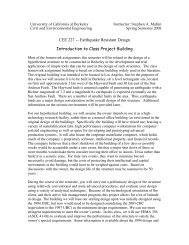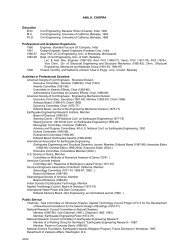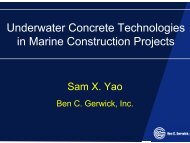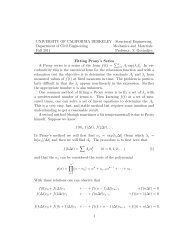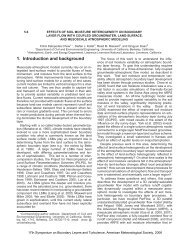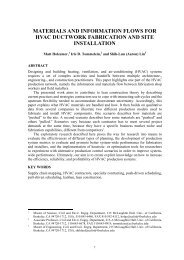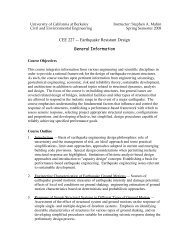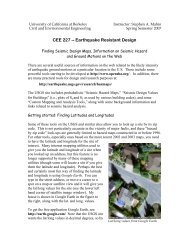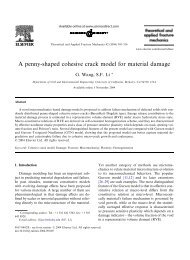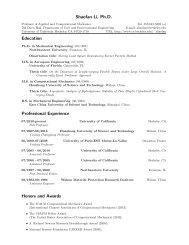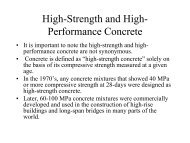Meshfree and particle methods and their applications - TAM ...
Meshfree and particle methods and their applications - TAM ...
Meshfree and particle methods and their applications - TAM ...
You also want an ePaper? Increase the reach of your titles
YUMPU automatically turns print PDFs into web optimized ePapers that Google loves.
14 Li <strong>and</strong> Liu: <strong>Meshfree</strong> <strong>and</strong> <strong>particle</strong> <strong>methods</strong> <strong>and</strong> <strong>applications</strong> Appl Mech Rev vol 55, no 1, January 2002<br />
are partitions of unity, <strong>and</strong> in most cases the linear completeness,<br />
or consistency is also enforced a priori; there is no<br />
compatibility issue left to be tested, unlike the incompatible<br />
finite element shape function. However, if there are not<br />
enough quadrature points in a compact support, or quadrature<br />
points are not evenly distributed, spurious modes may<br />
occur.<br />
Today, quadrature integration is one of the two major<br />
shortcomings the cost of meshfree <strong>methods</strong> is the other left<br />
when meshfree <strong>methods</strong> compared with finite element <strong>methods</strong>.<br />
Beissel <strong>and</strong> Belytschko 237 proposed a stabilized<br />
nodal integration procedure by adding a residual of the equilibrium<br />
equation to the potential energy functional to avoid<br />
use of quadrature integration. However, adding the additional<br />
term in potential energy means sacrificing variational consistency,<br />
hence accuracy of the formulation. Gauss quadrature<br />
integration error via different set-up of background cells as<br />
well as quadrature point distribution is studied in 238. Itis<br />
found that if the background cell does not match with the<br />
compact support of the meshfree interpolant, considerable<br />
integration error may rise.<br />
The simplest remedy is the local, self-similar support integration.<br />
Assume the meshfree shape function is compactly<br />
supported, <strong>and</strong> the support for each <strong>and</strong> every <strong>particle</strong> is<br />
similar in shape, eg a circular region in 2D, a sphere in 3D.<br />
Take the Element Free Galerkin EFG method for example<br />
Belytschko et al 59,63. For linear elastostatics, the stiffness<br />
matrix is<br />
K IJ <br />
<br />
B I t DB J d (79)<br />
where is the problem domain. If all the shape functions<br />
have the same shape of compact support a 3D sphere in this<br />
case, the above integration can be rewritten as<br />
K IJ <br />
I<br />
B I t DB J d (80)<br />
where I is the support of <strong>particle</strong> I.<br />
Because all shape functions are compactly supported, the<br />
integrals in the rest of domain, ie / I , vanish. And we<br />
only need to evaluate K IJ within I <strong>and</strong> Iu . Since<br />
every I ,(I1,...,n) has the same shape, once a quadrature<br />
rule is fixed for one compact support, it will be the same<br />
for the rest of compact supports as well. We can then integrate<br />
the weak form locally from one compact support to<br />
another compact support. Therefore, it is free of the background<br />
cell or any implicit mesh. Note that this is different<br />
from the global domain quadrature integration, since in our<br />
case compact supports are overlapped with each other.<br />
This local quadrature idea is extended by Atluri <strong>and</strong> his<br />
colleagues to form new meshfree formulations 80–83,239–<br />
242. The first formulation proposed by Atluri et al is called<br />
the local boundary integral equation LBIE.<br />
Consider a boundary value problem of Poisson’s equation<br />
239. One can form a boundary integral equation for a chosen<br />
subdomain s note that s has nothing to do with a<br />
<strong>particle</strong>’s compact support,<br />
uy ux ũ*<br />
s<br />
<br />
n x,yd u<br />
s n xũ*x,yd<br />
ũ*x,ypxd (81)<br />
s<br />
where ũ* is the Green’s function<br />
ũ*x,y 1<br />
2 ln r 0<br />
r . (82)<br />
For each <strong>particle</strong> in the domain , one can form a local<br />
boundary integral equation 81. Letting u h (x)<br />
i i (x)d i , one may obtain the following algebraic equations<br />
N<br />
i u i <br />
j1<br />
where<br />
K* ij su<br />
K*d ij j f i<br />
* (83)<br />
ũ*x,y i j<br />
<br />
n d ũ*<br />
j<br />
sq n x.y id<br />
ũ*<br />
j<br />
Ls n x,y id (84)<br />
f i<br />
* ũ*x,y i<br />
sq<br />
q¯d ū ũ*<br />
su n x,yd<br />
ũ*x,y i pxd. (85)<br />
s<br />
Those local boundary integrals <strong>and</strong> local domain integrals<br />
can be integrated by fixed quadrature rules. Sladek et al presented<br />
a detailed account on how to deal with singularity in<br />
numerical integrations 243. The obvious advantage of this<br />
formulation is that it does not need to enforce the essential<br />
boundary condition. Nevertheless, this formulation relies on<br />
a Green’s function, <strong>and</strong> it is limited to a h<strong>and</strong>ful of linear<br />
problems.<br />
Subsequently, Atluri et al 80,81 formed a local Petrov-<br />
Galerkin formulation MLPG with meshfree interpolant in<br />
the same local region s For linear elastostatics problem<br />
49, they form N local petrov-Galerkin weak forms. Each of<br />
them around a distinct <strong>particle</strong> I is,<br />
N<br />
j1<br />
where<br />
K ij d j f j (86)<br />
K IJ B I v T DB J<br />
s<br />
d v I J<br />
su<br />
d v I NDB J d<br />
su<br />
(87)<br />
f I v I<br />
st<br />
t¯d v I<br />
su<br />
ūd v I bd (88)<br />
s<br />
Again, s is not the compact support I , however, certain<br />
conditions must be imposed to s , such that K ij 0 at least<br />
for some ji. In practical implementation, the trial func-



